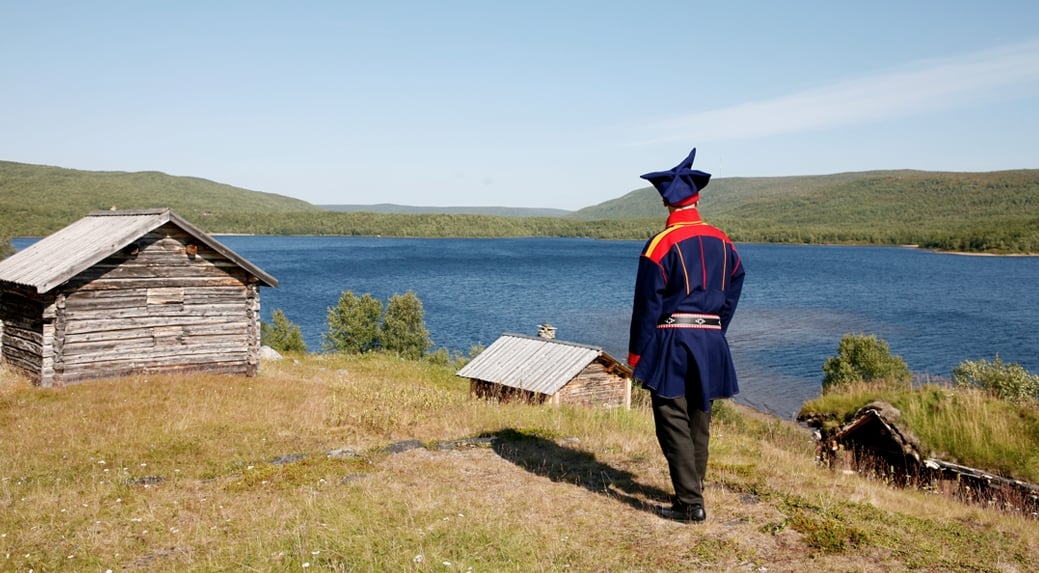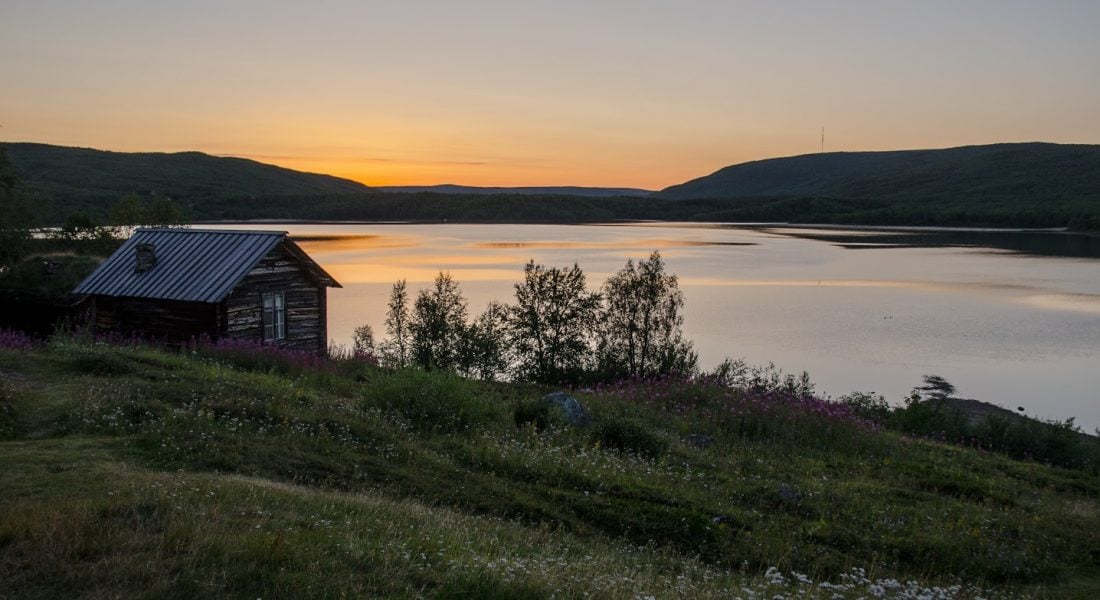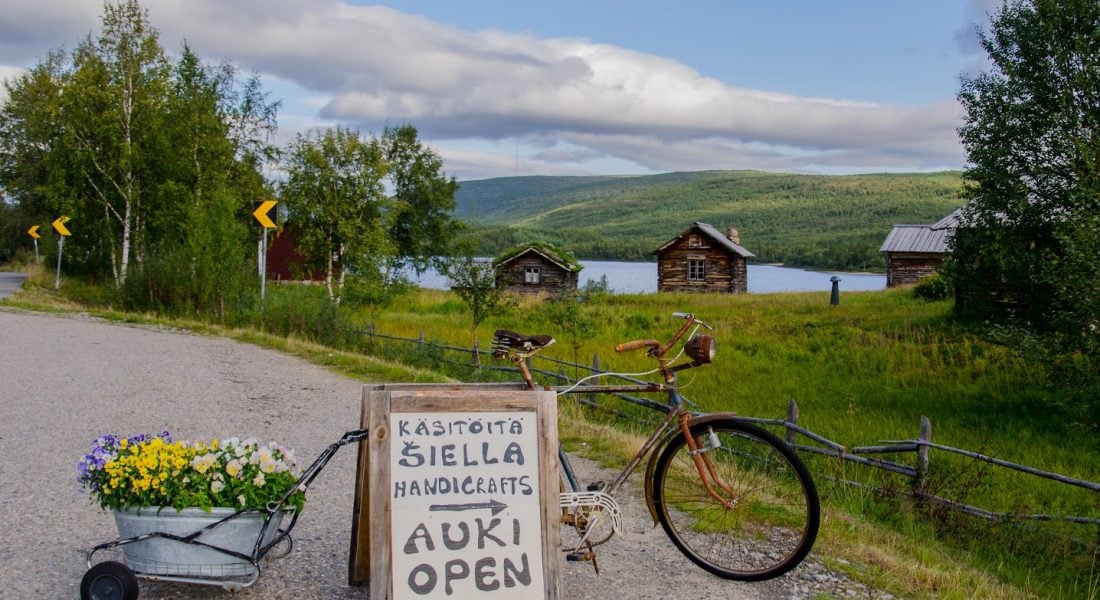The Utsjoki parish village
The Utsjoki Church, Church Huts, Vicarage, and Other Historic Sites on the Western Shore of Lake Mantojärvi (Máttajávri)
The Utsjoki church, church huts, vicarage, and other old building sites on the western shore of Lake Mantojärvi (Máttajávri) form an interesting and culturally significant ensemble, rich in events and stories.
Some of the huts date back to the 18th century. The church huts area used to be one of the central places in Utsjoki and was still actively used in the 1930s. At one time, there were about twenty huts, although some were later relocated. Others were destroyed or dismantled. Today, there are 14 restored church huts remaining on site. The open-air museum of the church huts is open to visitors year-round. In summer, you can also explore the huts with a guide, and enjoy delicious waffles sold to support the Utsjoki parish’s mission work. Additionally, during the summer, you can admire and purchase local handicrafts at the craft shop Šiella, run by a local artisans’ association.
The church huts have long served as a cross-cultural meeting and trading place, with people arriving from hundreds of kilometers away. The Church of Saint Ulrika, built in Utsjoki, was in use until the 1850s, and the sacristy from the original 18th-century church still stands. After a colorful history, a new stone church was completed in 1853 on the slope of Mantojärvi, and a new vicarage was built ten years earlier, in 1843, on the lakeshore. The stone church, completed in 1854, is built from gray granite quarried from the nearby cliff known as Kirkkopahta. The remaining sacristy of the old church is located at the edge of the old cemetery. The vicarage, designed by C.L. Engel and built in the 1840s, is a one-story Empire-style building. The courtyard includes traditional red-painted outbuildings.
The church cabins were owned by Sámi families and used for accommodation during major church festivals. Each cabin was built and owned by individual families, with the exception of the court and bailiff cabins. The cabins remained in use until the mid-1940s, and church-related activities (e.g., confirmation classes) continued in the area until the early 1970s. The Finnish Heritage Agency has restored the cabins, and in 1995 they were protected by a decision of the Finnish government as examples of Sámi residential and building traditions. In 2004, ownership of the area was transferred to the Utsjoki Church Cabin Association, founded by various families, the municipality of Utsjoki, and church representatives.
In the winter, people traveled to the cabins by reindeer, horse, on foot, or by skiing. In summer, they came by boat, rowing or poling. Journeys were long and often required overnight stays. The most important church festivals included Christmas, the Feast of the Annunciation, Easter, Pentecost, Midsummer, and Michaelmas. In addition to church services, people gathered in the cabins for devotions and religious meetings. Visitors usually stayed at least two nights, often longer. Alongside attending church services, they shopped and visited relatives and friends. A single small cabin might host up to fifteen people overnight, and the court cabin could accommodate up to twenty. Trading and markets took place at the cabins, and at times the area had up to two shops. Before the war, the use of money was still limited, and bartering—using handmade items, meat, fish, shoe hay, and game—was common.
Today, the church cabins are one of the most important attractions in Utsjoki. Visitors are encouraged to make a voluntary donation to the Utsjoki Church Cabin Association, which maintains the area. The church, vicarage and its courtyard, church cabins, the sacristy of Saint Ulrika with its cemetery, and the market field are all protected sites designated by the Finnish Heritage Agency.
The Ulrika Trail, built by the Utsjoki Church Huts Association, also highlights Sámi architectural and cultural history. The 2.3 km trail runs through the church landscape of Utsjoki, which is a nationally significant cultural environment. Information boards can be found near the church huts and at the lower parking area of the Utsjoki church (about 5 km from the Utsjoki village center toward Inari along Highway 4). The trail starts at the church huts, passes the old sacristy and the former market grounds. From there, you can take a shorter route or go via the current cemetery. The path loops back to the church alongside the old cemetery. From the church, you can also walk up Kirkkopahta hill along the old postal trail to a viewpoint. The route is marked with colored poles. The path from the church to the cemetery is accessible.
Please note that the Utsjoki church huts and their surroundings are of great cultural and historical significance, especially to the Sámi people. Respect the cultural heritage by not littering or leaving traces of your visit. Ceremonies are sometimes held in the church with guests in Sámi dress—please do not photograph anyone without permission. The sites are located on both sides of Highway 4, so use caution when crossing the road, as visibility may be poor in some spots. Park only in designated parking areas. When climbing Kirkkopahta, be mindful of the steep elevation changes and cliff edge, which poses a serious falling hazard. To prevent erosion, stay on marked paths only.






